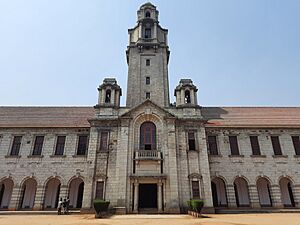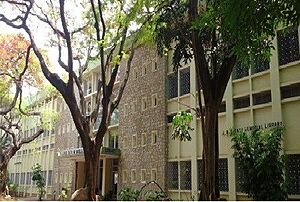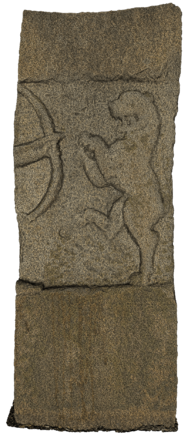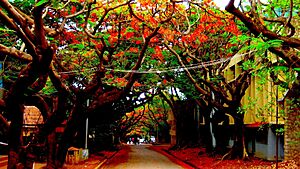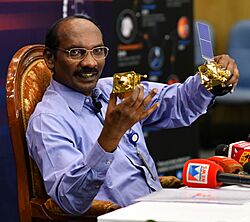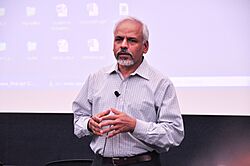Indian Institute of Science facts for kids
 |
|
| Type | Public research university |
|---|---|
| Established | c. 1909 |
| Founders |
|
| Accreditation | NAAC |
| Affiliation |
|
| Budget | ₹900 crore (US$150 million) (2025–2026) |
| Director | Govindan Rangarajan |
| Visitor | President of India |
|
Academic staff
|
481 |
|
Administrative staff
|
214 |
| Students | 5,286 |
| Undergraduates | 533 |
| Postgraduates | 2,010 |
| 2,743 | |
| Location |
,
,
560012
,
India
|
| Campus | Urban, 440 acres (180 ha) |
The Indian Institute of Science (IISc) is a top public university in Bengaluru, Karnataka, India. It is known for higher education and research in science, engineering, design, and management. The institute was started in 1909 with great help from Jamsetji Tata. Because of this, many people locally call it the Tata Institute. IISc became a special "deemed university" in 1958 and was recognized as an "Institute of Eminence" in 2018. This means it is one of the best educational institutions in India.
Contents
History of IISc
How IISc Began
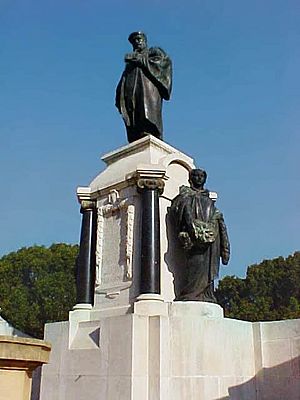
The idea for IISc came from a meeting between Jamsetji Tata and Swami Vivekananda on a ship in 1893. They talked about Tata's dream of bringing the steel industry to India. Later, Tata wrote to Vivekananda about his plan for a science research institute in India.
Vivekananda was very supportive of the idea. Tata then formed a committee to plan the new institute. They presented their proposal to the Viceroy, George Curzon, in 1898. A famous scientist, Sir William Ramsay, suggested Bangalore as the best place for the institute.
The land and other facilities were given by Maharaja Krishna Raja Wadiyar IV and Jamsetji Tata. The Maharaja donated about 371 acres of land. Tata also provided several buildings. The Maharaja gave money for building costs and annual expenses. The Nizam Mir Osman Ali Khan also contributed a large sum over many years.
The institute's official approval was signed on May 27, 1909. In 1911, the Maharaja laid the foundation stone. On July 24, the first students began their studies in Chemistry and Electro-Technology. In 1958, IISc was officially recognized as a university.
The first director of IISc was Morris Travers, who helped discover noble gases. The first Indian director was the famous Nobel Laureate, Sir C.V. Raman. IISc was also the first in India to offer master's degrees in engineering.
Recent Events at IISc
In 2005, there was a sad incident on the IISc campus where a professor from IIT Delhi passed away. Four other people were also injured.
In 2018, IISc was chosen as one of the first six institutes to be an "Institute of Eminence." This means it is considered a top-tier institution in India. In 2019, IISc shared its new motto: "Discover and Innovate; Transform and Transcend; Serve and Lead."
In 2022, IISc received a very large private donation of 425 crore Indian Rupees. This money was given to help set up a new medical institute for postgraduate studies.
IISc Campus Life
Main Campus in Bengaluru
The main campus of IISc is a residential area, meaning students and staff live there. It covers 400 acres in the heart of Bangalore city. The campus is about 6 kilometers from the main railway and bus stations. It is also connected by the city's metro system.
The campus is close to other important research centers like the Raman Research Institute and the Indian Space Research Organisation (ISRO). Many of these institutes have shuttle bus services connecting them to IISc.
The main campus has over 40 departments. It also has six cafeterias, a gym and sports complex, a football ground, a cricket ground, and dining halls. There are also hostels (dormitories) for students, a library, shopping centers, and homes for faculty and staff.
The campus is home to many different types of plants, both local and from other places. The roads on campus are even named after the trees that grow along them.
The Main Building, where the administration is located, has a classic architectural style with a gray tower. In front of it is a monument honoring J. N. Tata, reminding everyone of his generosity. This building was designed in 1912–13 and is a well-known landmark in Bangalore.
J. R. D. Tata Memorial Library
The J. R. D. Tata Memorial Library is the main library at IISc. Besides this main library, each department also has its own smaller library. The main library moved to its current building in 1965. In 1995, it was renamed after J. R. D. Tata.
The library has a large budget, with most of it spent on subscribing to academic journals. It receives over 1,734 different journals, and more than 10,000 journals can be accessed online. The library holds over 411,000 documents in total.
Historical Artifacts on Campus
In the late 1970s, a special stone carving called a hulibete veeragallu was found on the IISc campus. It dates back to the 10th century. These "hero stones" were put up to honor people who died bravely, often in fights. They are mostly found in the Karnataka region.
Even though the IISc hero stone doesn't have writing on it, experts believe it's from the 10th century. You can still see a person holding a bow, ready to shoot an arrow at a tiger. This is one of only three such tiger-hunting hero stones known in Bangalore.
Challakere Campus
IISc has a second campus in Challakere, which is much larger, covering 1500 acres. This campus has research centers and labs for things like solar power and climate studies. It also has centers for skill development.
Academics at IISc
Study Programs
IISc offers many different study programs, especially for advanced research.
Research Programs
Most students at IISc are doing research, working towards their PhD degrees. These programs involve some coursework, but the main focus is on a big research project that leads to a thesis. About 575 research students join each year.
There are also "Integrated PhD" programs. These are for students who have a 3-year Bachelor of Science degree. They can do advanced research in biological, chemical, mathematical, and physical sciences to earn their PhD.
Master's Programs
IISc offers two-year Master of Technology (M.Tech.) programs in almost all engineering departments. Students take core courses and can choose other courses and a research project.
Other master's degrees include Master of Management (M.Mgt.) for engineering graduates and Master of Design (M.Des.) for product design.
Since 2022, IISc has offered an online Master of Technology program. This is for engineers and scientists who are already working and want to improve their skills in areas like Data Science and Artificial Intelligence.
Starting in 2022, IISc also launched new Master of Science (MSc) programs in life sciences and chemical sciences. These programs focus on hands-on lab training and independent research projects.
Undergraduate Program
IISc started an undergraduate program in science in 2011 for students who have finished Class XII. This program offers a four-year Bachelor of Science (Research) degree or a five-year integrated Master of Science degree. Students can study Biology, Chemistry, Environmental Science, Material Science, Mathematics, and Physics. The program teaches students how different science fields work together in research.
A new undergraduate program, B.Tech. in Mathematics and Computing, aims to train future leaders in advanced technologies that use a lot of math, computer science, and data science. Students can get into these undergraduate programs through the JEE Advanced or the IISER Aptitude Test.
Supercomputer Education and Research Centre (SERC)
The SERC was created in 1990 to provide powerful computing facilities for students and faculty. It houses India's first petascale supercomputer, which was once the fastest supercomputer in India. SERC also conducts research and education programs related to supercomputers.
Working with Others
IISc works with many government organizations like the Indian Ordnance Factories, DRDO, and ISRO. It also partners with private companies and research labs. IISc encourages its faculty, students, and alumni to start new businesses. Some successful companies like Strand Life Sciences and Ittiam came from this initiative.
Rankings
| University and Institute rankings |
|---|
IISc is highly ranked both in India and globally. In 2025, it was ranked 211th in the world by the QS World University Rankings. In Asia, it was ranked 58th in 2024. The Times Higher Education World University Rankings placed IISc among the top 201–250 universities worldwide in 2024.
In India, IISc was ranked 2nd overall by the National Institutional Ranking Framework (NIRF) in 2024. It was also ranked 1st among research institutions and 1st among universities in India.
Campus Life and Activities
Events and Sports
Pravega is the big annual science, technology, and cultural festival organized by IISc undergraduates. It usually takes place in January.
Vijyoshi is another annual science camp for school and college students, hosted by IISc.
IISc also has active sports teams in cricket, football, badminton, and volleyball. They compete in various tournaments.
Music Club
Rhythmica is the oldest and most active music club at IISc. Its members include students and professors. IISc also hosts a local branch of SPIC MACAY, an organization that promotes Indian classical music and culture among young people.
Notable People from IISc
Famous Alumni
Many talented individuals have studied at IISc. Some well-known alumni include:
- Sudha Murty, who is the Chairman of Infosys Foundation.
- R Chidambaram, a former Principal Scientific Adviser to the Government of India.
- K. Sivan, who was the Chairman of ISRO.
Famous Faculty Members
IISc has also had many distinguished faculty members. Two former directors, C. V. Raman and C. N. R. Rao, received India's highest civilian award, the Bharat Ratna. Several faculty members have also been recognized with the Shanti Swarup Bhatnagar Prize for Science and Technology for their excellent contributions to science.
See also
 In Spanish: Indian Institute of Science para niños
In Spanish: Indian Institute of Science para niños
- Indian Institutes of Technology
- Tata Institute of Fundamental Research
- Indian Institutes of Science Education and Research
- List of universities in India


